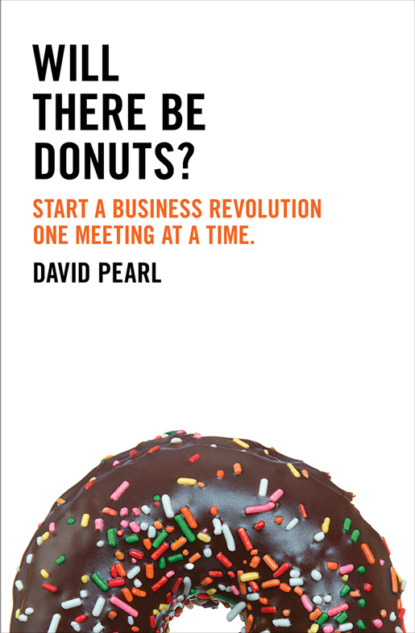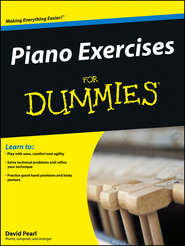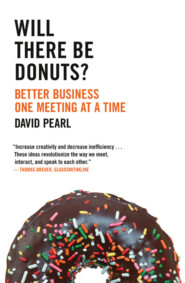По всем вопросам обращайтесь на: info@litportal.ru
(©) 2003-2024.
✖
Will there be Donuts?: Start a business revolution one meeting at a time
Автор
Год написания книги
2019
Настройки чтения
Размер шрифта
Высота строк
Поля
we start looking at it more holistically
we’re more respectful of it – it’s not a disposable commodity
we notice it repays our efforts when we take care of its vitality, rather than purely its efficiency
we realise that shutting it in an airless, windowless concrete box in a hotel basement, sorry Business Suite, may not be the best idea
we know it will have its good and bad days, just like us
Treat it as another metaphor if you like. For me, after many years of doing this work, it’s a reality. If I am observing a six-person meeting I’ll see seven actual participants: the six people present plus the meeting itself.
If something goes wrong, I ask people not to blame each other, but to look up and pay attention to what the meeting needs. Is it getting over-heated or over-pressured? Is the meeting running out of energy? Does it need a break? With very little practice this exercise greatly increases your awareness of what’s really needed in a meeting, moment to moment.
So, from here onwards, I want you/us to think of a meeting as a living being. And that we are not fixing them but keeping them healthy and vitally alive.
Unfortunately living beings don’t come with instructions. And if we want our meetings to function well we do need a way to keep track of all that’s happening – the obvious and not so obvious, the dogs that bark and those that don’t. Fortunately, I found one. In Peru.
I was in Lima with my circus-cum-opera company (long story) and wasn’t looking for a multi-dimensional meeting map. I was there to sing, eat gerbil and get altitude sickness. One morning, our director David handed me a book he’d found on a shelf at his hotel. Please forgive the cliché, but Ken Wilber’s A Brief History of Everything is genuinely a life-changing book. At least it was for me.
I urge you to read it if you have ever had the feeling that everything is connected but you are not sure how. The Integral approach (www.integralinstitute.org) that Wilber has pioneered is now being used the world over to help us think, act, govern, work and live in much more holistic, healthy ways. Back then, what struck me was how it could help us have great meetings.
At the heart of the book is a simple diagram. The really great ones are simple. It’s a two-by-two matrix (aren’t they always?) dreamed up by the novelist and science writer Arthur Koestler, who called it a ‘holon’.
What this diagram reminds us is that everything in the universe (including meetings) has an outside and an inside …
Meanwhile it is a ‘thing’ in itself and is also a part of one or more groups:
Combine them and you get four domains, which Wilber calls:
Think about yourself as you sit reading this book. You have a physical form – an outside made of flesh, bone and muscle, with limbs you can move and toes you can wiggle. That’s the right-hand side of the diagram.
To move to the left-hand side, close your eyes for a moment and become aware of what’s simultaneously happening in the interior you. Here you are a continuous ferment of thoughts, feeling, beliefs, pictures, senses.
To experience the top half, concentrate on all the aspects that make you unique and different from everyone else – the unique, separate you. And finally, as individual as you are, consider how many groups or ‘clubs’ you are part of: human race, family, company, people with the same name/star sign/language/height. You’ve moved into the bottom, collective half of the Holon.
Taken together, it’s a map of all we are experiencing moment to moment. In life. At work. And in meetings.
A meeting has an outside (where things are said and done) and an inside (what is going on beneath the surface – the world of beliefs, politics, emotions, hidden agendas …). It is made up of individuals – each with their identity and role – who interconnect (more or less effectively) as a group.
Building on the integral model, I call these four areas:
Of course we are living in all four quadrants at once. The lines and labels are artificial. However they provide a wonderful map to understand the anatomy of meetings and to ensure that, when we design or run them, we leave nothing out.
Take a breather, have a stretch. When you are back we’ll look at each of those areas in more detail.
The Why of Meetings
If you are in a meeting and wondering what am I doing here? it is time to pay attention to the top left quadrant.
Probably the most important moment in any meeting is one we don’t notice. We walk straight past it in our hurry to get the job done. It comes just after the start. You’ve arrived (or phoned in), settled in your chairs and are just discussing what the meeting is about when …
Stop.
Rewind.
There. Just before you say what the meeting is about. It’s the why moment. It’s the moment you can really energise the meeting, awaken, involve and engage the participants. If you miss it, you are going to have to work that much harder for this meeting to succeed.
Even real engagement pros sometimes miss that moment. When the blockbuster film The Gladiator was first tested on audiences it had a so-so reaction. It was clearly a great action film, but the audiences felt something was missing. Then director Ridley Scott added a scene, right at the start. It goes something like this:
Fade up out of black.
We hear an Asiatic woman’s voice, keening. We are in close up on a man’s hand drifting through a field of golden corn. We don’t know it yet, but the hand belongs to the hero, the Roman general Maximus, played by Russell Crowe. We are soon to see him leading his loyal troops into battle against the marauding Germanic hordes. But here he is the farmer remembering the cornfields of his native land. We see a wedding ring on his finger. There is a distant peal of children’s laughter and the thrum of a Spanish guitar.
This scene is not telling us about what this person does, but why he does it; the inner motive and driving force beneath his actions. We are being introduced to this person from the left-hand side of the quadrant (his inner life) before we drop into his daily existence, actions and plans.
In art it is absolutely common to make a distinction between a person’s visible actions and their invisible emotional life. In business, less so.
The Gladiator is a soldier on the surface. But within he is a doting father and husband. Beneath the surface of the successful professional soldier is a professional farmer who cannot wait to fight one last battle and return to his beloved home and tend the crops.
Nietzsche claimed, ‘He who has a why can bear almost any how.’ The Gladiator certainly tests that – his To Do list is daunting. It includes beating the German army, galloping across Europe (too late) to save his family, surviving slavery, battling his way to eminence as a gladiator, making his way to Rome and finally obtaining revenge by killing the evil Emperor. A full schedule indeed.
These whats all take energy. And where does the energy come from? His why. Though it is never said, we know from that first scene that the character is motivated not by belligerence, fury, bloodlust or revenge – but love.
Meetings aren’t movies. But the film-maker’s basic principle of engaging your audience from the start is a great one for you to practise in your meetings.
By the way, if you look back at the opening of this book, you’ll see me doing my best to grab your attention, just as you might at your next meeting. The first thing I did after saying hello was to mention the intent to make the world a more interesting place. Then I painted a picture, tried to excite you about the possibilities, gave you an idea of where we were going and why it was worth it.
These are all good techniques to steal and use at the start of every meeting. Start well, and you have a chance of finishing well.
What’s the Intent of your meeting?
‘Why are we meeting?’ you ask, and people will usually tell you what the meeting is for; the objective. Knowing the objective is important but not sufficient. Not if you want to really meet. It is possible to have a perfectly plausible objective and still completely waste your time. Once you know the objective, you want to be asking yourself and others the real question: why is that objective important/useful/valuable/worth doing?
Or in other words, what is your intention?
You may have a meeting where the objective is to discuss sales figures. But discussion is not the ultimate intent. It’s there so that you make great decisions, or navigate the next year well, or protect your investment or … or … or …
We are so used to collapsing intention and objective together we sometimes forget there’s a difference. When you buy a lottery ticket, your objective is to win. Your intention is about what you will do with the winnings.
Вы ознакомились с фрагментом книги.
Приобретайте полный текст книги у нашего партнера:
Приобретайте полный текст книги у нашего партнера:







